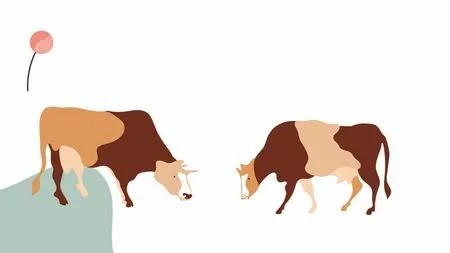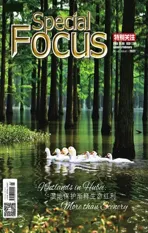牛niú
2021-03-22杨柳川
(杨柳川)
2021 is the Year of the Ox according to the Chinese lunar calendar.Individuals born in the Year of Ox are said to share certain traits with this animal,which are,loyalty,diligence,tolerance,and persistence.They are also believed to be somewhat headstrong,but quite dedicated.

A wave of fanatical supporters has been ringing in the Year of the Ox with great zeal and fervor since the first day of the lunar New Year.Curiously enough,they were not necessarily born in the Year of the Ox,nor are they Chinese nationals,they are actually stockholders from various cultures from all over the world.
But why would stockholders be so hyped up about the year of the Ox? First of all,the ox (牛) is synonymous with the bull.And certainly anyone who has ever thought of playing the market has heard the expression “bull market” (牛市 pronounced niú shì in Chinese),which is a term used to characterize market sentiment as fervent and optimistic,due to rising stock prices.Chinese and Westerners alike believe that the image of a hulking,powerful bull thrusting its horns upwards is a vivid image that represents a rising market.The character 牛 (niú) literally means cattle.The pictographic character 牛 is a distinct,iconic illustration of a bull’s head,longhorned and dauntless.
公历2021年是中国历法的牛年。牛在中国传统文化中有着重要的地位,是勤劳忠诚和百折不挠美好品质的象征。老人们认为生肖属牛的人会像牛一样勤劳坚毅、宽容大度,他们也像牛一样强壮而执着。
对于牛年,有一批最热切的拥趸,他们不只是属牛的人,也不一定是中国人,他们是遍布全球的股民,分属于各种不同的文化。
股市以“牛市”来命名,意指股市行情昂扬向上,主要是因为中西方人民都认同,俯身颔首继而高高扬起犄角的公牛,最能形象地展现出股票指数一路攀升、不可遏抑的上涨态势。汉字中“牛”的象形文字,就是一个个棱角分明、铁骨铮铮的牛头。
祭祀是古人生活中最重要的政治活动,而牛则是祭祀活动中最高贵的祭祀品。《说文解字》注:“牛,大牲也。”“牲”就是祭祀用的全牛。在古代,只有皇帝和诸侯王祭祀时才能使用牛,并且有严格的程序规定。大家所熟知的成语“庖丁解牛”,就是描述一位厨师替国君梁惠王宰牛的故事。另外,古代中国以牛为“耕稼之本”,牛是主要耕作畜力,是重要的生产工具,屠宰耕牛拿来食用,对于一个以农业为本的国家来说,是得不偿失的。因此,中国历朝历代都有保护耕牛的律法,如秦汉时期,杀牛等于杀人;唐朝规定,无故擅杀牛者,判刑一年半;北宋时期,屠宰牛必须向官府报告,否则要处以刑罚。
中国人爱牛、惜牛、敬牛,汉语中富含美好寓意并与牛相关的词语较多,如牛人、牛劲、执牛耳、牛刀小试、舐犊情深等等。

自古以来,无论是达官贵人、文人墨客,还是戎马将士,都对牛肉的美味充满着向往和赞誉。从三闾大夫屈原《招魂》中“肥牛之腱,臑若芳些”对膏腴美食的赞美,到诗仙李白《将进酒》中“烹羊宰牛且为乐,会须一饮三百杯”的豪迈;从司马光《将军吟》中“肥牛百头酒万石,烂漫一日供欢娱”的老夫聊发少年狂,到辛弃疾《破阵子》中“八百里分麾下炙,五十弦翻塞外声,沙场秋点兵”的一腔金戈铁马爱国情怀,都免不了牛肉氤氲的香气。
当中国进入工业时代,牛在祭祀与耕作上的用途已慢慢淡化,牛的价值渐渐转向食品加工和制造行业。牛奶、牛肉以营养价值高而深受人们喜爱,牛皮、牛角可以制成药品、食用明胶、皮革、工艺品等,牛的价值愈加凸显出来。
The importance of 牛 can be traced back to ancient sacrifice,the most important ceremony in the China of old.A bull was seen as the holiest possible offering to the gods.This was recorded as “牛,大牲也” (niú,dà shēng yě),in which 牲(shēng) refers to a strong bull without defect for sacrificial offerings,inShuowen Jiezi,the first dictionary analyzin g the forms and origins of Chinese characters.Only an emperor and his vassal kings were privileged enough to use 牛 in sacrificial practices.The well-known fourcharacter idiom 庖丁解牛 is pronounced páo ding jiě niú,and means “skilled and magical crafts manship.” It tells us a story about a master chef deftly butchering an ox for King Hui of Liang.
In addition,cattle were regarded as fundamental to agriculture in ancient China,and thus related to national peace and stability.As cattle were the major source of labor in farming,and an important factor affecting agricultural productivity,it was far from beneficial to slaughter them for food in a country wholly dependent on agriculture.Therefore,there were myriad laws and regulations passed to protect 牛 in ancient China.To kill any cow was a crime equivalent to murder in the Qin Dynasty.In the Tang Dynasty,killing a cow groundlessly was punishable by at least one and a half years in prison.Any unauthorized slaughter of cattle also resulted in severe consequences in the Song Dynasty.
牛 has long been cherished and respected by the Chinese.Nowadays,the Chinese language is rife with exquisite expressions and intriguing idioms containing the character 牛,such as 牛人(niú rén),牛劲 (niú jìn),执牛耳 (zhí niú ěr),牛刀小试 (niú dāo xiǎo shì) and 舐犊情深 (shì dú qíng shēn),which mean “a big shot,” “great strength,” “an acknowledged leader,” “a modest first display of a master’s ability,”and “parental love,” respectively.For the Chinese who have long believed that “food is of the first necessity to the people,” beef was naturally served up as a favorite of multitudes of gourmands,many of whom just happened to be,officials,aristocrats,and literati.
Qu Yuan,the illustrious poet and the minister of the Chu State,praised the “Stewed tendons of beef,like rosemary’s sweet perfume” in his great work Elegies of Chu.Li Bai,crowned the greatest poet in China,recited in his poem “Invitation to Wine”:
Kill a cow,cook a sheep,make merry to eve shall we,
Fine wine three hundred cups,all undulate with glee!
Sima Guang,a great Chinese scholar and poet in the Northern Song Dynasty,compiled a monumental work,Zizhi Tongjia n (Comprehensive Mirror in Aid of Governance).As a statesman of morality,he wrote verses to describe soldiers’ great joy and satisfaction when eating beef:
Fat game,sweet meat a hundred head of bull,
Dry wine,sweet mead a thousand flagon full.
Jubilations,jubilations,gladsome this morn be,
Exultations,exultations,joyous day of felicity.
Xin Qiji,a heroic general and p atriotic poet in the Southern Song Dynasty,also chanted lyrics on the battleground:
Eight-hundred miles of hard treks,brave soldiers share a roast,
Fifty scores of sweet harp strains,bold warriors make a toast.
Battlefields cloaked in autumn’s tan,a song of triumph rings
Gathering beyond the city walls,of victory the troops sing.
From timeless verses such as this,we sense the spirit of 牛 as well as the fragrance and delicacy of beef pervading every facet of Chinese culture.
As China entered the industrial age,the purpose of 牛 has shifted from serving sacrifice and farming,to an ingredient in food preparation,as well as a host of other applications.For example: milk and beef are especially favored thanks to their great nutritional content; cattle skin and horns have been made into products we use every day,such as medicine,edible gelatin,leatherwear,and handicrafts.The cow,the bull,and the ox alike have been found all the more valuable.
